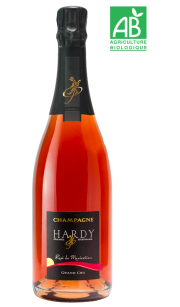Rosé de Saignée Champagne
Rosé de Saignée
Upon tasting, the rosé champagne de saignée is generally richer, more vinous and fruitier. The tannins passed through the skins during the vinification process give a more tannic wine compared to a blended champagne. The colour is also more pronounced, as are the aromas. More concentrated, the rosé de saignée champagne is considered as a very expressive wine, reflecting the singularity of a well-defined terroir.
It is a safe bet for connoisseurs and amateurs alike!
- Previous
- Next
What is a Rosé de Saignée champagne?
To focus on the so-called "saignée" method, it is important to remember the most common one: the blending method. This method consists in blending a white wine, before the bubbling process, with about 5 to 20% of red Champagne wine. This mixture then gives the rosé colour that we can appreciate once the bottle arrives on our table.
Contrary to this technique, rosé de saignée is vinified with red grape varieties like a white wine (notably Pinot Noir and Pinot Meunier) but the winemaker lets the grape skins macerate with the juice, which is clear. It is then the anthocyanins contained in the skins that give the juice its colour.
How is a Rosé de Saignée made?
There are several steps to follow in order to produce a rosé de saignée champagne. After the harvest, destemming (separation of the berries from the plant parts) is carried out, then the berries are gently crushed so that the juice can be extracted from the grapes. Maceration follows, and the winemaker must manage time precisely. Indeed, the maceration time is very important during this stage: if you want a lightly coloured rosé de saignée, you will only let the juice macerate for a few hours.
Then, the juice will be racked to separate it from the skins and will be able to start its fermentation in the best possible conditions.












